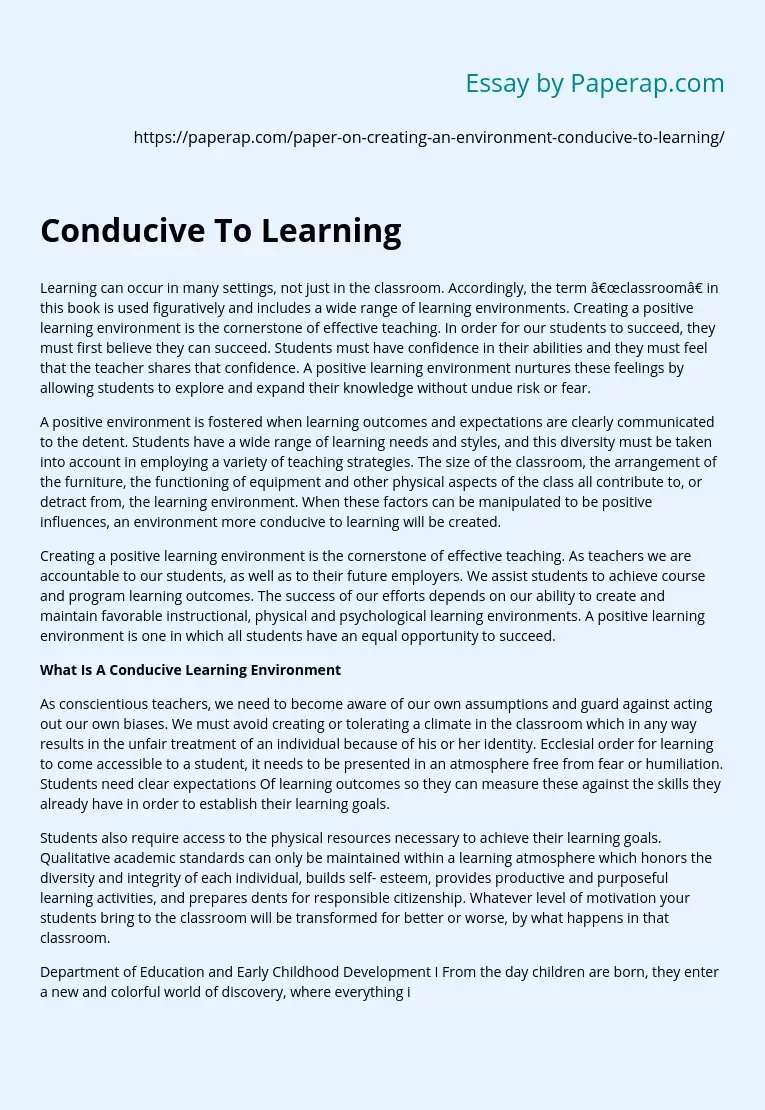Creating an Environment Conducive To Learning
Learning can occur in many settings, not just in the classroom. Accordingly, the term “classroom” in this book is used figuratively and includes a wide range of learning environments. Creating a positive learning environment is the cornerstone of effective teaching. In order for our students to succeed, they must first believe they can succeed. Students must have confidence in their abilities and they must feel that the teacher shares that confidence. A positive learning environment nurtures these feelings by allowing students to explore and expand their knowledge without undue risk or fear.
A positive environment is fostered when learning outcomes and expectations are clearly communicated to the detent. Students have a wide range of learning needs and styles, and this diversity must be taken into account in employing a variety of teaching strategies. The size of the classroom, the arrangement of the furniture, the functioning of equipment and other physical aspects of the class all contribute to, or detract from, the learning environment.
When these factors can be manipulated to be positive influences, an environment more conducive to learning will be created.
Creating a positive learning environment is the cornerstone of effective teaching. As teachers we are accountable to our students, as well as to their future employers. We assist students to achieve course and program learning outcomes. The success of our efforts depends on our ability to create and maintain favorable instructional, physical and psychological learning environments. A positive learning environment is one in which all students have an equal opportunity to succeed.
What Is A Conducive Learning Environment
As conscientious teachers, we need to become aware of our own assumptions and guard against acting out our own biases. We must avoid creating or tolerating a climate in the classroom which in any way results in the unfair treatment of an individual because of his or her identity. Ecclesial order for learning to come accessible to a student, it needs to be presented in an atmosphere free from fear or humiliation. Students need clear expectations Of learning outcomes so they can measure these against the skills they already have in order to establish their learning goals.
Students also require access to the physical resources necessary to achieve their learning goals. Qualitative academic standards can only be maintained within a learning atmosphere which honors the diversity and integrity of each individual, builds self- esteem, provides productive and purposeful learning activities, and prepares dents for responsible citizenship. Whatever level of motivation your students bring to the classroom will be transformed for better or worse, by what happens in that classroom.
Department of Education and Early Childhood Development I From the day children are born, they enter a new and colorful world of discovery, where everything is new and unfamiliar. To get to know themselves, others and their worlds, they need to feel safe and confident. Creating rich, stimulating, engaging environments for them to explore will ensure that they are active participants in their own learning. The Early Learning and Child Care Curriculum is based on the vision all children can grow to their fullest potential with dignity, a sense of self worth, and a zest for living and learning.
To reach this point requires a holistic approach to early learning and care, where all of the curriculum elements function in harmony with each another. The curriculum promotes healthy development by emphasizing responsive relationships, stimulating environments and learning through play. Based on up-to-date research on how to maximize children’s learning, the curriculum appeals to the uniqueness of each and every child. This factor contributes to the innovative nature of the curriculum, and allows its contents to be practiced across a variety of cultural, linguistic and social backgrounds.
By implementing its teachings at the earliest age possible, children are prepared for a smoother transition into primary school, and given a foundation of learning that will support them throughout their lives-Caring and supportive relationships are fundamental when creating an environment that encourages healthy learning experiences for children. Positive relationships foster feelings of safety and trust that all children need n order to explore and experiment with confidence.
Creating an Environment Conducive To Learning. (2019, Dec 05). Retrieved from https://paperap.com/paper-on-creating-an-environment-conducive-to-learning/

